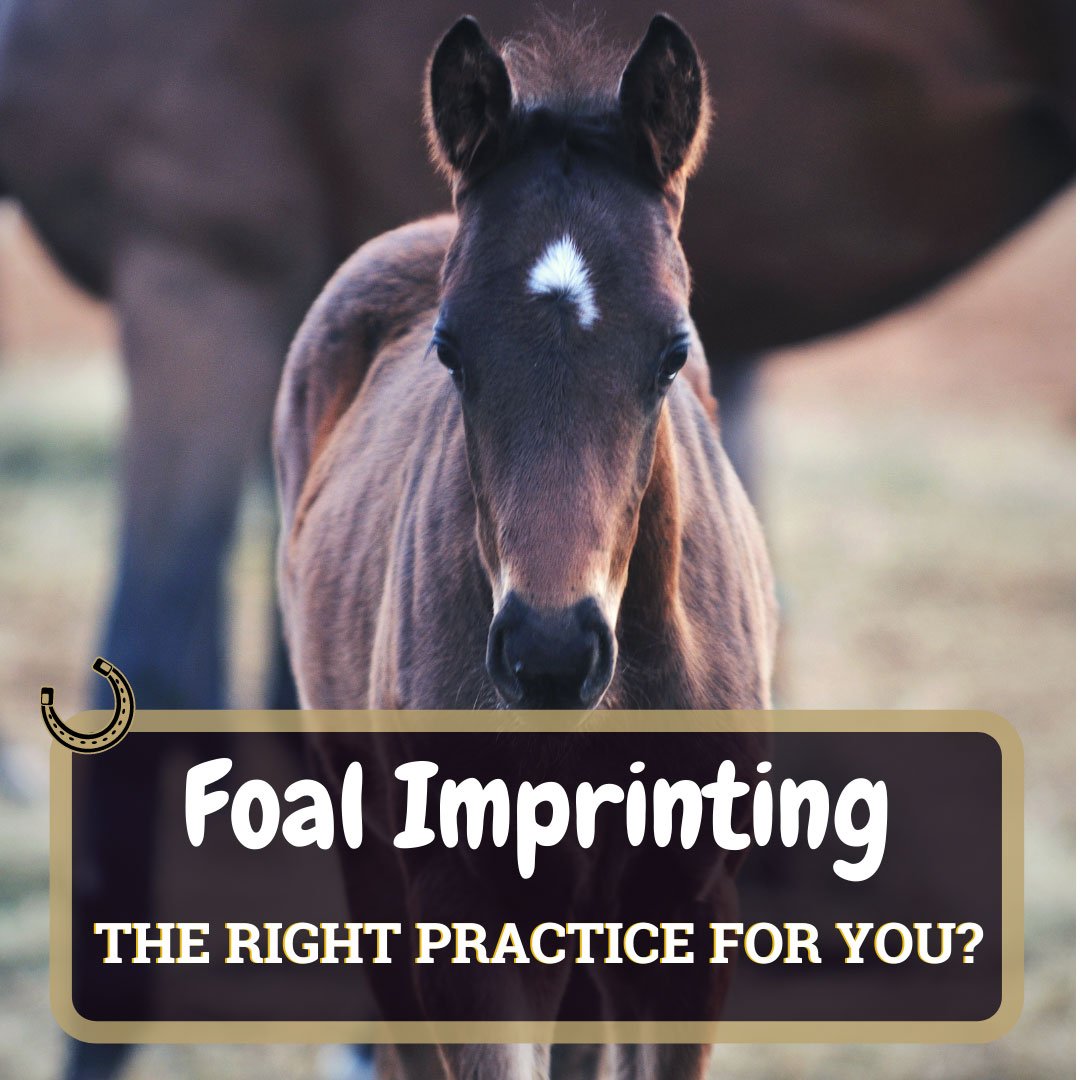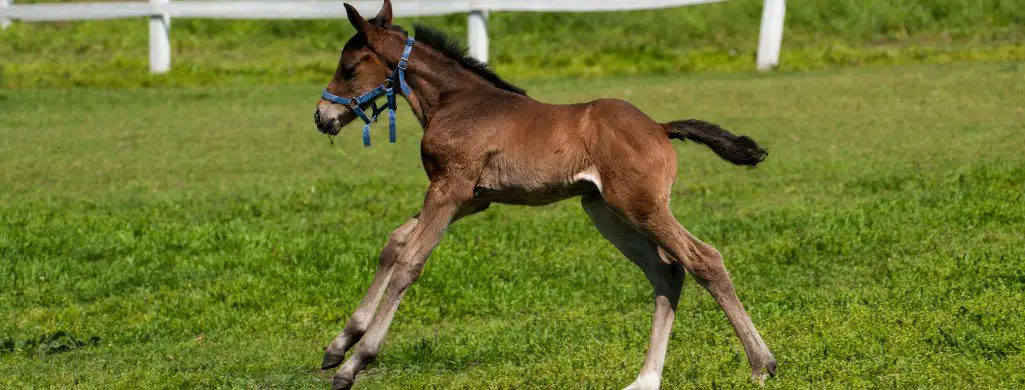
The beginning of life possesses limitless mind possibilities for all creatures. At this stage, they can be molded and impressed into anything anyone wishes them to become. For newborn horses, the natal guidance into submission and affability by the owner is what experts call foal imprinting. It is a controversial topic with many research studies and opinions labeled for it and against it.
Could this at-birth procedure help to make a quiet and friendly horse in the future for vet treatment, shoeing or riding activities? There is no simple yes or no answer to that.
[toc]
What is Foal Imprinting?
Foal imprinting was first brought to light by Konrad Lorenz, an Australian zoologist who observed that geese developed a lifelong attachment to their first handler when they hatch. Robert M. Miller, DVM, later popularized the practice through his many books on the subject.
Dr. Miller realized, in his several years of practice, that the foals he had helped deliver were effortless to deal with in his follow up visits. Based on his practical experiences, he compiled the imprinting techniques he had proved effective in his Imprint Training Manual.
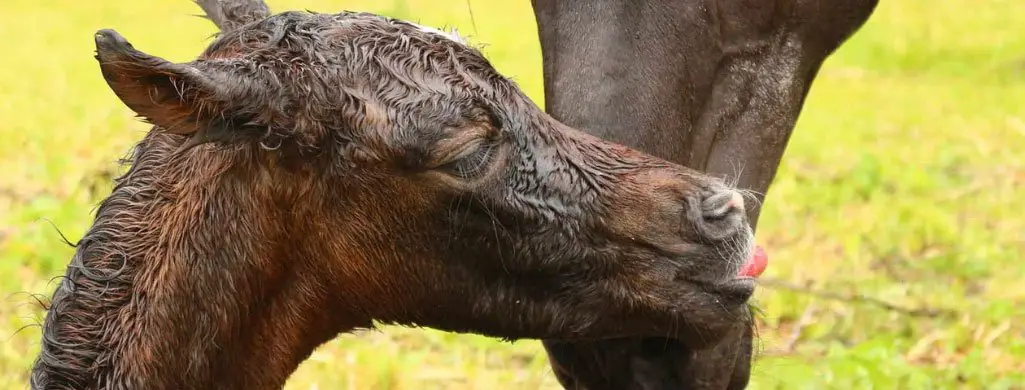
Miller states that foal imprinting has three main objectives, including:
- Strengthening the bond with you– your smell, sound, and appearance gets ingrained on the animal’s long term memory
- Desensitizing the colt to what it may consider frightening stimuli
- Teaching the animal to be submissive and respect you as the leader
The Foal Imprinting Process according to Miller
The mare must be friendly for the imprinting process to proceed without hiccups. Right after birth, you get to the foal and touch and rub his body. The success of this technique will depend on how effectively you handle the newborn horse.
First, when the foal is a few minutes or hours old, gently place him on the ground so that he lies on his side. Kneel to the side and hold his front and rear legs to keep him still. Get a second person to help you fold his head towards his rear, then reach over and start rubbing and touching each part of his body with medium aggressiveness.
The rubbing and touching procedures should happen when the young horse is standing and after he has nursed. Some owners prefer to rub the foal with a towel over his body before rubbing. You should naturally expect the horse to show some resistance when touching his ears and muzzle.
Experts insist that the imprinting should involve touching the foal’s legs and tapping his feet to prime him for his future farrier sessions psychologically. Similarly, spread your imprinting to his perineum, tail-head, and groin. These areas deserve sensitization for future vet sessions, according to foal imprinting experts.
Be sure to touch and rub the teats (for female horses), scrotum, penis and the rectum. Manipulate with your gloved and lubricated hand to get the horse accustomed to such exams in the future, experts say. Once your newborn foal accepts these procedures, flip him around and do the same on the other side.
Important to Remember
The imprinting process is rarely a one-day affair at birth. Imprint training typically goes on till the foal stops weaning. Regular grooming experts say, can help turn them ‘helplessly submissive’ and put their total trust in you. However, inconsistencies in your imprint training may produce the opposite effect when they become overly sensitive.
Remember that the learning, when they are young, is fast and permanent, so proceed with caution and teach the right lessons. You don’t want the horse to be a strong-willed creature with strong aversions for humans.
It’s never a sped-up process, take it slow, doing one thing until the horse completely relaxes and submits before moving on to another job. If you are flexing the foal’s leg or rubbing his ear and you stop before he gets accustomed to the feeling, all he will remember in the future is to jerk whenever he is touched in those places.
Emphasis should be placed on controlling movement. Be sure to teach the foal how to move back, forward or sideways on your command. Teach him how to stand patiently, lead willingly or rotate.
In the wild, horses exercised dominance over their peers by controlling their movement. Subordinates move or stop when the dominant horse moves. If you are the one controlling the young horse’s movement, you teach him a lifelong lesson that you are the dominant one, and that he should be submissive to you.
Dr. Miller asserts that missing lessons on movements create horses that are tolerant of handling, but are disobedient when it comes to controlling to their movement.
Why Horse Imprinting?
Horses are prey to other species and are thus naturally suspicious, frightful, and with a proclivity to flee. The young ones of all prey animals, including horses, are born ready. They can see, hear and smell, and if there is danger, at that very moment of their birth, they can get up and run for their lives. Nature gives them an ability to instantly bond with their mothers and the rest of the herd.
A newly born horse does not fear humans yet. If you happen to be there and proceed about it the right way, the animal can bond with you too, according to advocates of foal imprinting. You can supposedly program them to tolerate and recall all and everything that pertains to horse-human interactions, from the owner’s side to the farrier to the vet. That way, they say, the horse in his adult life will be less wary of unfamiliar experiences and objects or animals.
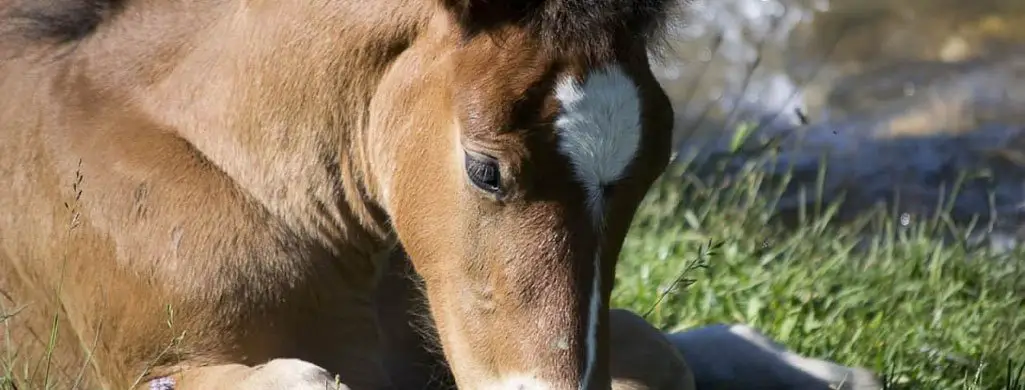
For instance, by tapping the bottom of his feet 50 times after birth, Dr. Miller says that in the future, the horse will have no problem being shoed or hoof trimmed. He will recall the sensation and remain fearless. It’s believed the young animal could get accustomed to the sound of clippers and sprays before he is even one hour old.
The other compelling reason that foal imprinting proponents put forward is that wild horses have a leader. The latter is often an older mare that leads not by strength but by the molding of behavior and character.
Other horses submit to the leader by bowing their heads and foals by mouthing. As a horse owner, foal imprinting helps you assume the leading figure and earn his submissiveness without fear, according to Miller. The result is long-lasting trust and respect for you, and a desire to follow you.
Arguments for Foal Imprinting
Dr. Miller postulates that foal imprinting is similar to the Mozart Effect observed in humans. The researcher believes that as classical music can have a calming effect on the newborn if played before and after the baby is born, so does foal imprinting help to create friendly horses.
The Mozart Effect was a study by Gordon Shaw and his associates, investigating the effect of classical music on spatial reasoning. The researchers gave kids standard tests on abstract spatial reasoning after the listening sessions. Their findings included a temporary improvement in spatial thinking. Subsequent Mozart tests showed that playing music to unborn babies and infants can keep them happy. But given the transient effects of the calming and IQ enhancing nature of Mozart music, Dr. Miller’s allegations sound even more preposterous to those that oppose foal imprinting.
Animal behavior studies show that neonatal handling of foals can indeed reduce their reactivity to stressful conditions and reduce their fears of humans. Many animal behaviorists affirm that the neonatal period is the right time to decrease the anxiety, aversion, and self-defense towards future handling.
In many studies, foals that are consistently handled from birth to four months of age become fast learners and easier to train compared to those that get no handling.
The handling referenced by Fiske and Potter, 1979 involves brushing, leading and teaching restraint. The researchers found that relaxed foals learn better and are easier to train later in life compared to stressed foals. It has thus been established across all scientific quarters that young horses are quicker and more willing learners compared to mature ones.
A survey of 21 breeding farms revealed that there are extreme differences between imprinted foals and those not handled in the way they approached standing motionless persons. Similar behavioral differences were observed in the way the horses sought or averted human touch and the way they reacted when approached.
These studies strongly show that regular human-horse interaction may help to shape and influence the way the animals perceive humans. But there is lacking consensus as to how and when the ‘imprinting’ should be done and whether the positive results can be long-lasting.
Contradicting opinions and findings
Researchers caution the absolute belief of information and recommendations from anecdotal evidence and personal experiences. Such is how Dr. Miller’s findings are described in the scientific world. Even though animal behaviorists confirm that it is possible to build a strong bond between an animal and its caregiver through neonatal handling, many are quick to pronounce that it produces no long term advantages.
Mal and McCall (1996) handled newly born foals for 10 minutes daily for two weeks. Compared to the control group, the researchers found no evidence that handling foals affected their performance or ease of manageability.
Many scientists find fault with DR. Miller’s approach of forcing a foal into submission until it relaxes. The basis for any success in that undertaking, experts say, is that the foal has to learn that struggle does not get it free. The result, for strong and flighty foals, could be injuries and stress.
Another danger lies in interfering with the maternal bond between the mare and the foal. Dr. Miller proposes that foal imprinting should start before even the umbilical cord is severed. The first thing after any newborn comes into this world should be feeding. Getting there too early and doing all those procedures on the young horse risks his normal bond with the mare.
Extreme distress as an adverse effect of Miller’s foal imprinting was proven by McCall et al., 1985. Over handling of the newborn horse at this early stage, researchers believe, can impair the mare’s abilities. Foals separated for too long from their dams showed an insecure attachment to the dams even in adulthood.
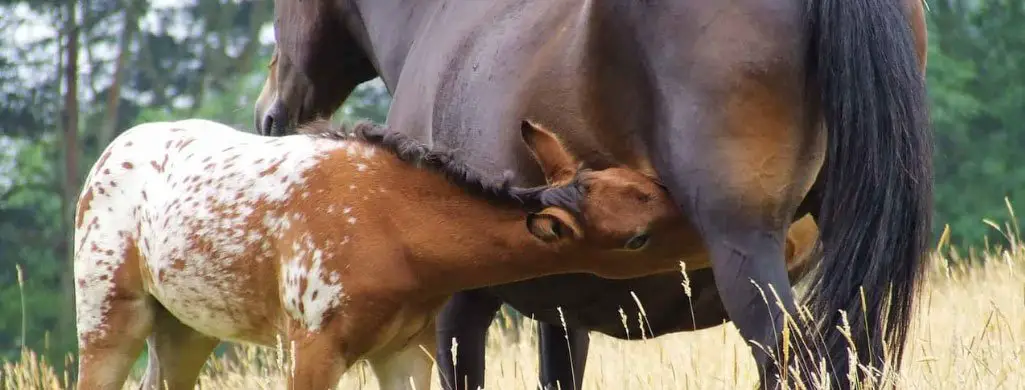
In several studies, handled foals displayed abnormal suckling activity, including excessive chewing and teat seeking. The early birth feeding is essential to supply the young foal with antibodies in the mare’s colostrum. If imprinting delays and later impairs the young horse’s ability to feed, you may be exposing the foal to bacterial dangers. Rectal manipulation also leaves behind ‘open’ and free for the entry of microbes.
Positive Effects of Foal Imprinting
Daily imprint training may successfully improve the foal’s reaction to handling, people and objects. This is important in creating a friendly horse that is not fearful of the owner’s training, saddling and riding, the farrier’s hoof care and the vet’s treatment. It establishes the behavior pattern that acclimatizes the horse, possibly, to all such activities in the future to serve as a useful animal.
Early training could assure and strengthen the relationship between the horse and the owner. The horse bonds and submits to the owner, which may make your work of care and training much easier. At-home grooming and inspection of the young horse become an easier task after desensitization.
Horses, being prey and flight animals need to be taught not to fear. That’s what the desensitization bit in foal imprinting helps to accomplish. Otherwise, simple stimuli such as a touch from you could elicit frightening stimuli for the animal. In their jerky and flighty movements, an un-imprinted horse could cause injuries to you and your family, or himself.
Through the imprinting session, the yearling learns performance basics, including haltering and response reinforcement. This is crucial in racehorses and lays the foundation for a smooth future in performance training, one would say. The colt learns to be a better athlete only by realizing that you, the trainer is trustworthy. The animal learns to respond to voice commands, touch signals, and wands.
Horses are born with hereditary tension like other prey animals. Eliminating that tension through proper foal imprinting may help to improve the quality of life for the animal. How, if you ask, is by enhancing their freedom of movement, balance, and coordination. Human assisted feeding, if the mare gets into problems, will be easier and help to keep your horse healthier. Young and first-time mares often run into milk production challenges.
Adverse Effects of Foal Imprinting
Excessive bonding to humans can result from over-handling the foal. The horse may grow up not distinguishing between you and other animals. The compelling into submission part of the training suggested by Miller can turn a horse into a pet, one would say. At their tender age, behaviors such as sucking and nipping on your fingers may be cute, but they are not acceptable for older animals.
Most imprinting techniques teach the foals to submit from fear. Many consider Miller’s invasive procedures as ‘inhumane’ for the animal.
Denying the yearling the early hours of his birth to bind with the mother can lead to feeding problems. As seen earlier, the young horse may also grow unhealthily attached to their mother even later in life. That may be as a result of stresses and traumas of imprinting.
In the first few hours after birth, the young horse needs feeding (for colostrum antibodies), and the mother needs to shed off her placental tissues. Early imprint training, experts warn, may interfere with these activities. The result could be an increased risk of infections for both mare and foal.
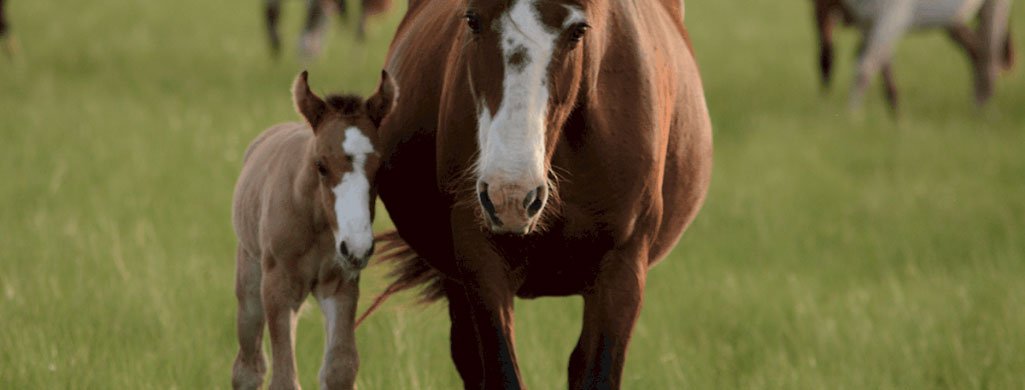
Foal Imprinting: Suggested Ways to get it Right
Ensure that foals stand within an hour after birth and that they nurse within two hours. The mare should expel her fetal tissues within three hours of foaling.
A vet should be by your side within 24 hours after birth to examine the new foal. A physical exam is enough at this tender age.
Let the mare and foal bond in the brief moments after birth. Allow the mare some rest as well before foal imprinting.
Start handling the foal after they have fed, and the mare is settled down. Don’t force the touching and rubbing. The idea is to reinforce positive experiences whenever the animal sees you. Work with the foal for short sessions every day.
Avoid sticking your fingers up his rectum or mouth –foals have weak immune systems at birth, and this action exposes them to bacterial infections.
Do not humanize the foal or turn him into a pet. Horseplay may be fun at their tender age, but it will be dangerous for you once the animal is fully grown.
What’s the Takeaway?
Foal imprinting is the training that occurs during the brief receptive period soon after foaling and forms the young horse’s future psychological response to an individual, object or sensation. The handing can have both positive and negative effects on your young horse. Be sure to talk to your vet for guidance on how to go about it.

